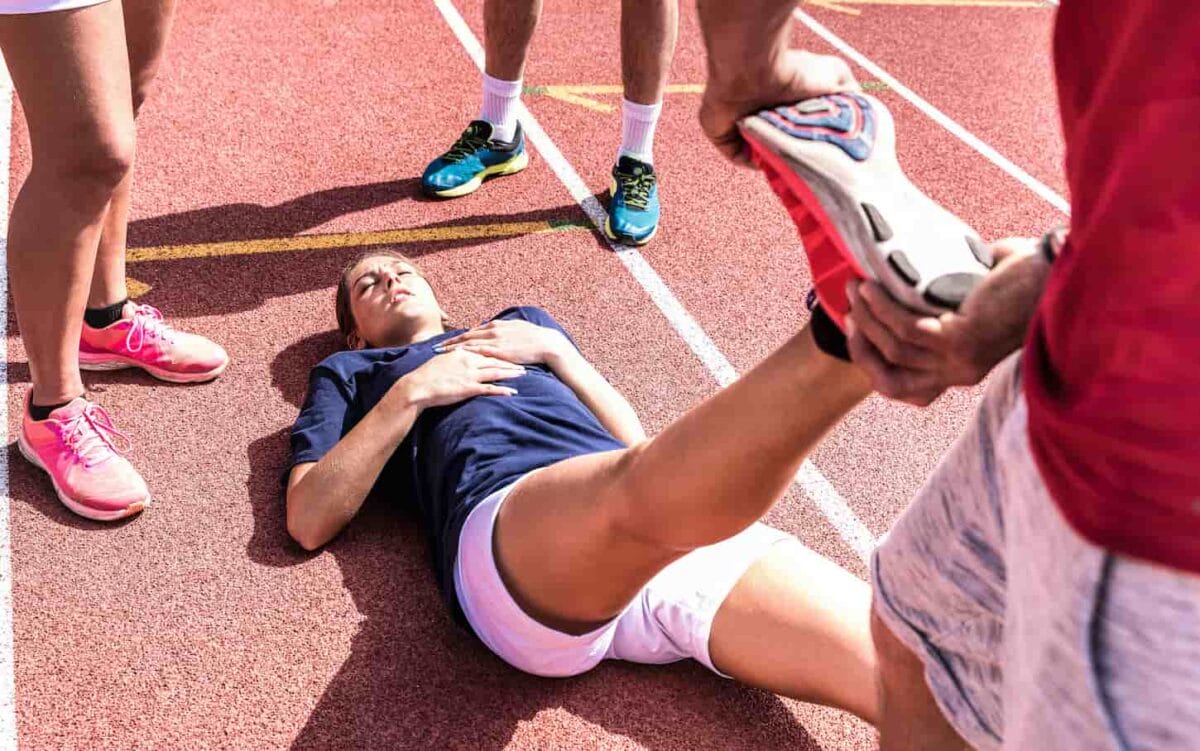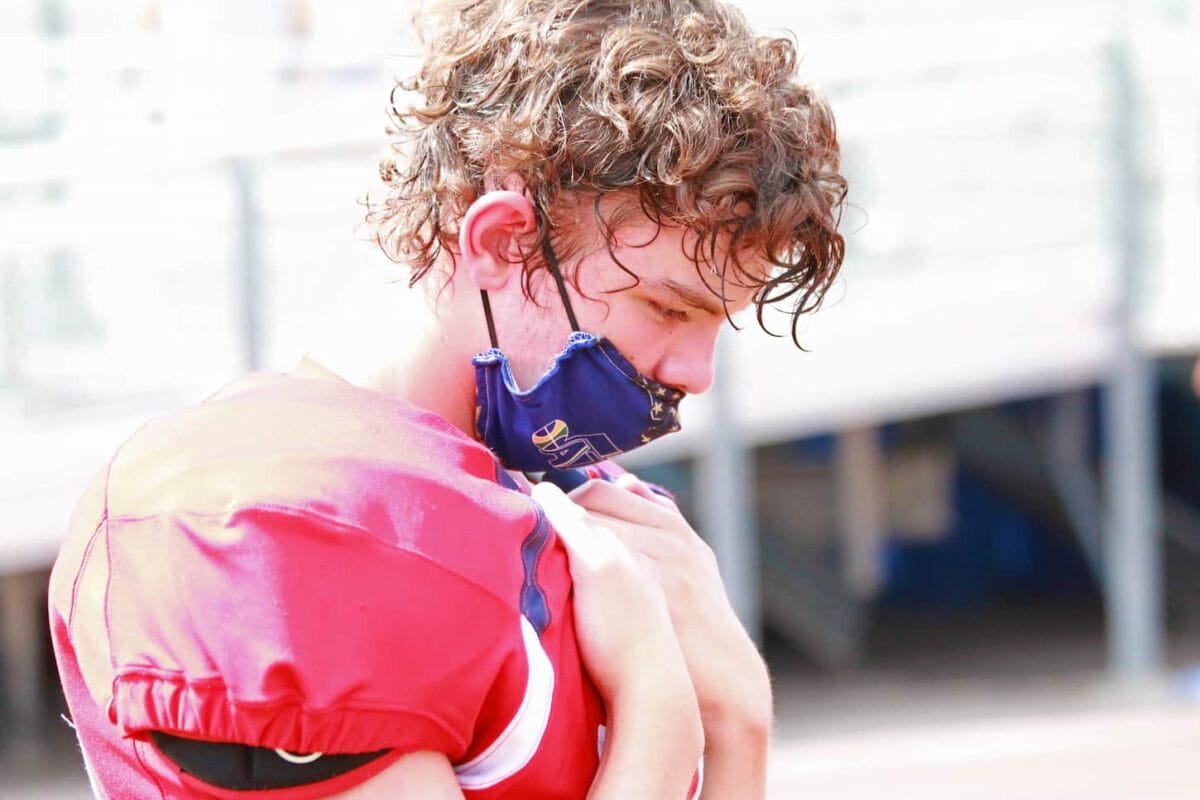Burnout – we hear this word often lately. We use the term “burnout” more often than we should. Sometimes we overuse the term, and by doing so, it may lose its meaning. Burnout should be taken seriously; it is a medical condition many student-athletes face.
Burnout is an overtraining condition where student-athletes experience severe exhaustion (mental, emotional, and/or physical) and poor athlete performance. The treatment for burnout is simple; student-athletes need to take a break and rest.
Unfortunately, many student-athletes experience burnout. It occurs when an athlete doesn’t properly recover after competition or training, resulting in emotional and physical fatigue. When this happens, they experience weakened immune systems, hormonal imbalances, and mood changes.

What Are the Symptoms of Burnout in an Athlete?
The 3 most common burnout symptoms in athletes are apathy, exhaustion, and feelings of being a failure. Other burnout symptoms include muscle and joint pain, fatigue, weight loss, a weak immune system, mood changes, insomnia, difficulty completing daily tasks, increased recovery time, and reduced competitive quality.
Burnout looks different in every student-athlete. Generally, these three symptoms occur the most often: exhaustion, apathy, and feelings of failure.
How can a good coach recognize signs of burnout in an athlete?
A good coach should notice when a student-athlete is skipping workouts, isn’t satisfied with a training schedule, or feels fatigued and frustrated. This is why a coach needs to know the behavioral baseline of their team members.
Good coaches should keep their eyes open when observing an athlete’s behavior. Remember, a coach is important in an athlete’s professional life and can be a parental figure.
For example, a student-athlete is usually positive with lots of energy and is never late for training. Then, suddenly, that behavior drastically changes, then the coach will know something is wrong.
A coach’s job is to prevent burnout and look after their student-athletes. Open communication and trust between a coach and an athlete are crucial. Students should be able to confide in their coach if they start feeling worn out.
How Should Student-Athletes Deal With Burnout?
The student-athlete should stop training for a while. The time varies—it depends on a couple of factors, such as an athlete’s personality, the type of sport, competency level, and the symptoms of burnout.
The best way to deal with burnout is to ask a medical professional for advice. Here are a few solutions if a doctor and coach give the green light.
A complete break from training
Sometimes student-athletes have to take a total break from training. Unfortunately, young athletes have a hard time taking a complete break. Most times, they have a fear of so-called setback training.
Setback training is also one of the reasons why athletes push themselves to the limits and eventually feel burnout. The good news is this is reversible. As much as training and staying in shape is important, so is the rest.
A change in the environment
For some student-athletes, changing the environment is just what they need—for example, trying different training methods or training groups as an alternative. The lack of motivation or a need for change is valid and a common feeling athletes go through.
Student–athletes should acknowledge them and find a different environment that will spark that old feeling of passion and love for the sport.
An adjustment of training
Sometimes all the student-athlete needs is a different training program. This can mean more rest, less training, different methods, or the same training with different intensity and volume. Any kind of new and fresh perspective can be transformative for the athlete.

What Can Student-Athletes Do to Avoid Burnout?
Prevention is the best way to avoid burnout. Practice a healthy and balanced lifestyle. Get plenty of rest and allow for plenty of variation to prevent burnout.
Prevention sounds simple and easy; it must be a trick, right? Well, it’s the truth. Usually, when we talk about sports, we mention the benefits of playing them. But there is another side of sports not mentioned enough, and that is burnout.
In the present condition, any sport is becoming more competitive, resulting in burnout. That is why it is important to have a balance in every sphere of life. So, how do we prevent burnout?
Listen to your body
We’ve heard this cliché phrase thousands of times, but it makes sense. Athletes need to listen to what their body is telling them. They should nourish it with healthy foods, hydrate before and after training, and breathe properly during workouts.
Get a good night’s sleep
Getting a good night’s sleep is another popular phrase; again, it makes sense. A night of good quality sleep will and can prevent burnout. It helps athletes recover much faster from injuries and relieves stress and anxiety.
Sleep plays a big role in better training, athlete performance, and overall health.
Relax and enjoy downtime
By relaxing, we mean the athlete should have some fun. In competitive sports, winning the game is the goal. But somewhere along the way, we forget to enjoy the game, which is why we first fell in love with the sport. Don’t forget that! Have some fun!
Rest, rest, and rest
Rest after a workout—this is what our bodies need. Putting our bodies under pressure isn’t exactly a mindful approach to healthy living. Our bodies need to recover and rest after a high-intensity workout. Recognizing when our body needs a break is the best way to prevent burnout.
How Many Student-Athletes Experience Burnout?
Burnout is a common experience for student-athletes. Influential research from the 1990s in the Journal of Applied Sports Psychology showed that around 72% of student-athletes have experienced staleness during the sports season; around 66% experienced overtraining; and 47% experienced burnout.
We have gathered information and numbers on how many student-athletes experience burnout. Hopefully, these numbers will give us a perspective on how it should not be taken lightly.
Regarding statistics, we focused primarily on the group of student-athletes, but to learn more about other athletes, plenty of research-based articles are available online to reference.
Unfortunately, research on burnout and overtraining is insufficient. Luckily some studies show how physical training can cause psychological and physiological responses in athletes.
Regarding genders, around 25% of male and 30% of female student-athletes have reported stress and anxiety due to burnout. Stress and anxiety are common burnout symptoms that male and female athletes suffer from.
If burnout isn’t treated on time can lead to even more severe side effects. Unfortunately, research has also shown that only 10% of student-athletes will ask for help.
The ugly truth is burnout symptoms look like depression. So, many athletes are misdiagnosed with depression and are on antidepressants. This is one of the reasons why so many sports professionals are educated in this area so that students can get proper treatment.
Do young athletes get burned out?
Burnout does not discriminate by age; it can affect anyone, whether their child is in high school or college. When children and young adults no longer enjoy the sport, they often withdraw from the activity. Of course, not every withdrawal from the sport is caused by burnout.
Many factors explain why children and young adults develop burnout.
Environmental factors
- High-intensity training volumes
- High-performance expectations which can be enforced by self or others
- Intense competition
- Poor coaching practices
Personal factors
- An excessive need to please other people
- Non-assertive personality traits
- Perfectionism
- High Anxiety
- Low self-confidence
At a very young age, children are encouraged to play sports and push limits to succeed. So, many young athletes perform at the highest level possible and even play multiple sports in the same season. Not every high-performing young athlete feels burnout, but some of them do.
Sometimes when a child is put at a high-performance level at a very young age, the pressure can be overwhelming. Young athletes are still emotionally developing and don’t have the skills to cope with high-intensity feelings.
Usually, they don’t want to disappoint their coach, teammates, and parents, so they go all out.

Why Do Student-Athletes Quit?
For student-athletes affected by burnout, quitting seems like the only choice left. Most times, intense competition and early specialization alienate athletes from the sport.
Long story short, it’s not fun anymore. The good news is potential burnout can be prevented. It’s important to focus on becoming a well-rounded athlete and create an environment good for training and competition.
Early specialization shouldn’t be a primary focus—just like playing multiple sports in the same season. Another common mistake is poor coaching.
Some coaches use the same training frequencies, patterns, and methods with extra fitness workouts. Also, competitive schedules can be overwhelming.
By the time the child goes to college, there isn’t much they can learn. They only experience more of everything, but it’s the same; nothing is new and fun. More doesn’t always mean better.
Key Takeaways and Next Steps
We shouldn’t underestimate burnout. It leads to severe health problems if it’s not properly managed. The best remedy for burnout is rest—it’s as simple as that.
The difficulty is for the athlete to recognize their body’s signals. That is why it’s important to have parents’ support, surround themselves with a good coach and environment, and have fun along the way!
Need some ideas to add fun to your workout? Take things back to grade school level fun with our Slip and Slide Kickball: Complete DIY Game Guide.
Resources
Learning from your own experiences is important, but learning from others is also smart. These are the sources used in this article and our research to be more informed as a family of sports nuts wannabes.
- Athlete Burnout. (n.d.). Lurie Children’s. https://www.luriechildrens.org/en/specialties-conditions/athlete-burnout/
- Burnout In Youth Athletes: Risk Factors, Symptoms, Diagnosis, and Treatment | MomsTeam. (n.d.). https://www.momsteam.com/burnout-in-youth-athletes-risk-factors-symptoms-diagnosis-treatment
- Harris, L. (n.d.). Physical Burnout: Effects On Young Athletes. Norse News. https://shsnorsenews.org/6464/opinion-editorial/physical-burnout-effects-on-young-athletes/
- How to Spot, Avoid, and Recover from Exercise Burnout | ISSA. (n.d.). https://www.issaonline.com/blog/post/how-to-spot-avoid-and-recover-from-exercise-burnout
- Lawton, J. (2022, June 8). Understanding How Athlete Burnout Happens and How to Prevent It. TrainingPeaks. https://www.trainingpeaks.com/coach-blog/understanding-burnout-how-prevent/
- Mirza, M. (n.d.). Burnout: Why I Quit. The Forest Scout. https://theforestscout.com/34788/in-between-the-lines/burnout-why-do-athletes-quit/
- News Detail. (2021, August 9). ACSM_CMS. https://www.acsm.org/news-detail/2021/08/09/the-american-college-of-sports-medicine-statement-on-mental-health-challenges-for-athletes
- Richmond TS, Amsterdam JD, Guo W, Ackerson T, Gracias V, Robinson KM, Hollander JE. The effect of post-injury depression on return to pre-injury function: a prospective cohort study. Psychol Med. 2009 Oct;39(10):1709-20. doi: 10.1017/S0033291709005376. Epub 2009 Mar 2. PMID: 19250582; PMCID: PMC2741535.
- Silva, J. M. (1990). An analysis of the training stress syndrome in competitive athletics. Journal of Applied Sport Psychology, 2(1), 5–20. https://doi.org/10.1080/10413209008406417
- The American College of Sports Medicine Statement on Mental Health Challenges for Athletes. (2021, August 9). American College of Sports Medicine. https://www.acsm.org/news-detail/2021/08/09/the-american-college-of-sports-medicine-statement-on-mental-health-challenges-for-athletes.
- The BASES Expert Statement on Burnout in Sport. (2019). Bases.org.uk. https://www.bases.org.uk/imgs/tses___issue_61_autumn_19_expert_statement_online__pages_579.pdf
- Understanding Student-Athlete Burnout. (2014, December 10). NCAA.org. https://www.ncaa.org/sports/2014/12/10/understanding-student-athlete-burnout.aspx
- Valle, C. (2020, April 17). How to Prevent Athlete Burnout. SimpliFaster. https://simplifaster.com/articles/prevent-athlete-burnout/
- 6 Ways to Prevent Athlete Burnout – Complete Athlete Training. (2022, March 25). https://completeathletetraining.com/2022/03/25/6-ways-to-prevent-athlete-burnout/
